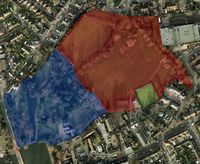Kingdom of Copan
Kingdom of Copan | |
|---|---|
|
Flag | |
 Copan in red, the rest of Orly in blue, UK not highlighted | |
| Capital | N/A |
| Official languages | English |
| Demonym(s) | Copanese |
| Government | Absolute monarchy |
• Monarch | HM Queen Emma I |
| Establishment | 19 July 2010 |
The Kingdom of Copan is, along with the Kingdom of the Grove, a sovereign state within the nation of Orly. One of the Carshalton Nations, Copan is a protected state of the Empire of Austenasia.
History
Early history
The Kingdom of Copan is a successor state of the Caesarship of Orly, created when Caesar Calum divided the original Caesarship into two - the Kingdom of the Grove and the Kingdom of Copan. Copan was made an absolute monarchy, and the throne given to King Declan I (of Moylurg, later renamed Wilcsland) by Caesar Calum. However, most decisions of government were taken by a Viceroy, the then Crown Prince Jonathan of Austenasia, who ruled Copan on behalf of the King.
On 8 December 2010, the Lord Regent of the Grove abdicated. King Declan I assumed the throne of the Grove as Regent under the terms of the edict Caesar Calum had decreed when he divided Orly in two, but then announced a reunification of the two Kingdoms on that same day, declaring the "Tsardom of Orly" with himself as Tsar.
Wilcslandian rule
The declaration by Declan I that Copan and the Grove were now reunified under him ultimately resulted in a state of war between Declan I and Esmond III, Emperor of Austenasia, who most Orlians regarded as their overlord. This war saw no actual fighting, with there being little desire for conflict between the Austenasian and Orlian people. The only "battle", a brief unopposed Austenasian occupation of part of Orly, did not involve any part of Copan.
The war ended with Declan I becoming joint Emperor alongside Esmond III, immediately making his new Tsardom far more acceptable to the Orlian people. However, discontent at the continued lack of official recognition of the Grove/Copan divide which had grown up over the latter half of 2010 resulted in Declan I appointing on 8 March 2011 a vassal monarch, Prince Miles, to rule Copan as a subdivision of Orly, under the authority of the Viceroy and as a vassal to the Tsar. Prince Miles was replaced as Copan's local ruler on 24 April by Prince Joseph, a former Austenasian knight, who was in turn replaced on 2 August 2011 by Esmond III himself, who at the time was still titular joint Monarch of Austenasia.
On 14 January 2012, Declan I declared Orly to be a constituent country of the United Kingdom of New Wessex, putting it into political union with his native Kingdom of Wilcsland. The vassal monarchies of Orly were abolished, and Copan's princedom became a ceremonial title, to be held by the heir to the Wilcslandian throne. This was immensely unpopular amongst the Orlians, and led to many abandoning the nation. For the next year and a half, little of note took place in Copan, and social meetings there of the Orlians became increasingly rare.
Liberation
2014 floods
In January 2014, the Secluded Place and much of the Plain of Copan were deluged in a flood.
Government
Copan has been ruled as an absolute monarchy since its creation, but in practice its monarchs have always had very little actual power over domestic affairs. The Orlian population is very similar to a commune - however, the leader of the nation has always been acknowledged and their titles respected by the Orlians. The main de facto duties of the Copanese ruler are to advance culture and to represent the kingdom internationally.
While under the rule of Declan I - who lived over seventy miles away in Wilton - a viceroy was appointed to govern in his name. From the foundation of Copan on 19 July 2010 until the declaration of the Tsardom of Orly on 8 December later that year, Copan was an independent kingdom ruled by Declan I.
On 11 September, the king rejected imperial suzerainty, but did not explicitly renounce the Emperor's right to appoint a successor. It was only when Declan openly refused this right with the foundation of the Tsardom that war broke out. The supporters of Declan emerged victorious, and for the next two and a half years Copan was part of the Tsardom of Orly, a unitary state. Dissatisfaction eventually led to Declan allowing his Viceroy - who for the entirety of the Tsardom period was Jonathan, Crown Prince (and later Emperor) of Austenasia - to appoint vassal Princes of Copan to act as local deputies. With the declaration of the United Kingdom of New Wessex in January 2012, the position of Prince of Copan was transformed into a ceremonial title.
Upon the Liberation of Orly on 24 June 2013, Copan was re-established as an independent state under the suzerainty of the Emperor. Declan I was deposed, and Emperor Jonathan I appointed the incumbent Emma I as Queen of Copan, the kingdom's first female ruler.
List of Copanese monarchs
| Image | Name | Title | Reign | Notes |
|---|---|---|---|---|
 |
HM King Declan I | King of Copan | 19 July 2010 - 8 December 2010 | |
 |
HSH Prince Miles | Prince of Copan | 8 March 2011 - 24 April 2011 | Local deputy to the Viceroy of the Tsar |
 |
HSH Prince Joseph | Prince of Copan | 24 April 2011 - 2 August 2011 | Local deputy to the Viceroy of the Tsar |
 |
HIM Emperor Esmond III/ HM King Ptolemy IV |
Prince of Copan | 2 August 2011 - 14 January 2012 | Local deputy to the Viceroy of the Tsar |
 |
HRH Prince Ciaran | Prince of Copan | 14 January 2012 - 24 June 2013 | Held throne as a ceremonial title |
 |
HM Queen Emma I | Queen of Copan | 24 June 2013 – present | Appointed by the Emperor upon the Liberation of Orly |
Geography
Copan comprises just over half of Orly. It is mainly comprised of open areas of grass, such as the Plain of Copan and the Playing Field. Major geographical features include:
- East Bank is the name given to an area to the extreme east of Copan (and Orly). It was formerly the site of an artificial tributary of the River Wandle constructed in the 1700s which would have started at the Grotto in Carshalton Park before joining the Wandle just to the north of Orly, but due to a falling of the water table the tributary has been completely dry for some years now (despite pipes under Carshalton High Street and Ruskin Road keeping its course intact) and only a dry river bed remains, although puddles do form during wet winters.
- The Secluded Place is the capital of Copan. Situated directly to the west of the northern-most area of East Bank, it comprises of a large deep dip in the ground surrounded by trees, almost completely secluding it from the rest of the park (hence its name). Stone steps lead down from East Bank to the Secluded Place, the bottom of which is littered with large pieces of broken masonry, the origins of which are unknown. A large pipe covered by grating to the north of the Secluded Place, as well as its proximity to East Bank, strongly suggest that its origins lie with those of the former artificial tributary of the Wandle, meaning that at some point it may have been submerged in water. Due to its extremely secluded nature, it is allegedly sometimes used by users of cannabis, earning it the pejorative nickname of Stoner's/Smoker's Wall. One tree has the Latin ciphers of Copanese monarchs from Caesar Calum to Prince Miles carved into it, and is known as the Copanese Regnal List.
- The Midgets' Base (not to be confused with the Midget Base, capital of the Midget Empire) is the site of a former military base built by the Midget Army and Word Life Gang in March 2004 during the First Battle of the Grove. It is located at the fenced border between the Plain of Copan and the Football Pitch, and due to a slight retreat of the bushes and shrubs which comprised the main fortifications of the base there are few physical remains - the last major remnant, a large wooden board, remained on the ground in the area for some time but disappeared at some point between October 2011 and July 2012.
- The Plain of Copan is the large field in the centre of Copan which makes up roughly half of the Kingdom.
- The Playing Field is an enclosed area in the north of Copan, formerly used as a football pitch.
